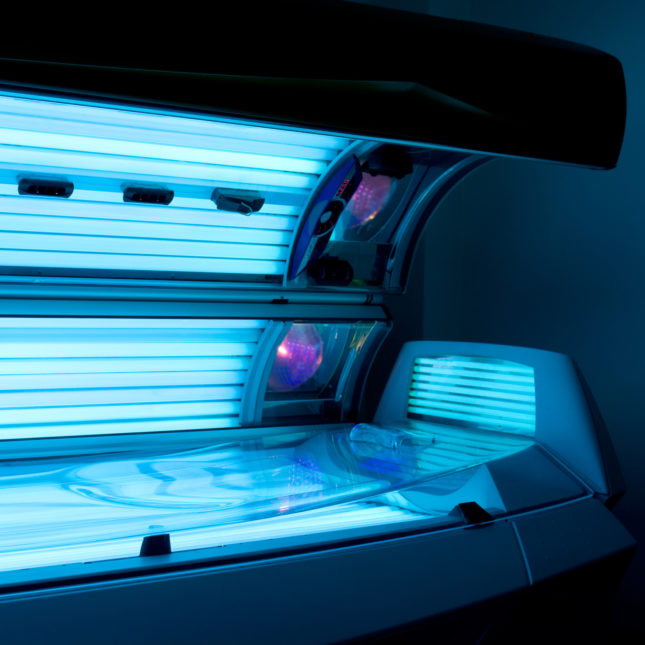


Is a tanning bed really safer than the sun? Will indoor tanning help your body make all of the vitamin D it needs? Findings from years of scientific studies have answered these and other burning questions about indoor tanning.
Here are 10 research-backed facts that may surprise you.
1. Tanning beds are NOT safer than the sun. Science tells us that there’s no such thing as a safe tanning bed, tanning booth, or sun lamp. Just one indoor tanning session can increase the risk of developing skin cancer (melanoma by 20%, squamous cell carcinoma by 67%, and basal cell carcinoma by 29%).1 The evidence that indoor tanning dramatically increases your risk of getting skin cancer is so strong that the U.S. Food and Drug Administration (FDA) requires warning labels on all indoor tanning equipment.
2. Tanning — indoors or with the sun — makes your skin age more quickly. Wrinkles, age spots, and loss of skin firmness tend to appear years earlier in people who tan. Anyone who tans can also develop leathery skin, which people who never tan don’t get.
3. Using tanning beds can cause a serious injury. In emergency rooms across the United States, people are treated for burns, loss of consciousness, and eye injuries caused by indoor tanning.
4. Getting a base tan cannot prevent sunburn. Many people believe that using a tanning bed to get a base tan will prevent sunburn. Absolute myth. If you have a base tan, you can still burn. Every time you tan or burn, you also damage the DNA in your skin. The more you damage your DNA, the greater your risk of getting skin cancer.
5. Getting enough vitamin D from tanning beds isn’t possible. You may have heard that your body makes a lot of vitamin D when you use a tanning bed. It doesn’t. The bulbs used in tanning beds emit mostly UVA light; however, your body needs UVB light to make vitamin D. To get vitamin D safely, board-certified dermatologists recommend eating a healthy diet. If you’re still not getting enough vitamin D, consider taking a supplement.
6. Becoming addicted to tanning is a real risk. Growing evidence indicates that tanning can be addictive. About 20% of 18- to 30-year-old white women who use indoor tanning show signs of addiction.3 They find it hard to stop tanning. When they don’t get a steady dose of UV rays, they feel fidgety or depressed.
7. Tanning (indoors or outside) can make stretch marks more noticeable. The best way to hide stretch marks is with a self-tanner.
8. Giving customers “false and misleading information” has been a common practice at tanning salons. A study run by the U.S. House of Representatives’ Committee on Energy and Commerce made a startling discovery. During this study, staff at tanning salons were asked questions about the risks of indoor tanning.
Investigators found that 90% of staff at tanning salons said indoor tanning is not a health risk for a fair-skinned teenage girl.4 Many staff at tanning salons even said that tanning has health benefits.5 This led the U.S. House of Representatives to report, “The vast majority of tanning salons contacted by Committee investigators provided false information about the serious risks of indoor tanning and made specious claims about the health benefits that indoor tanning provides.”6
9. Looking tan year-round is possible with a self-tanner. Many people say they use tanning beds because they like the way a tan makes them look. A self-tanner offers you a way to look tan without increasing your risk of developing early wrinkles, leathery skin, and skin cancer. Applied the right way, self-tanners look natural — and won’t give you orange skin, streaks, or splotches. How to apply self-tanner Keep in mind that when you use a self-tanner, it’s important to wear sunscreen that offers broad-spectrum protection, SPF 30 or higher, and water resistance. A self-tanner cannot protect your skin from the sun.
10. Quitting (or never starting) indoor tanning can help you live longer. By choosing not to tan, you reduce your risk of getting many types of skin cancer, including melanoma. The Centers for Disease Control and Prevention estimates that if no one younger than 18 years of age ever used a tanning bed, we could prevent about 61,839 melanomas and 6,735 deaths due to melanoma.7
It’s never too late to start protecting your skin from the sun and indoor tanning beds. As soon as you do, your body starts to repair some of the damage caused by the UV rays. And that’s a fact.
Source https://www.aad.org/public/diseases/skin-cancer/surprising-facts-about-indoor-tanning
